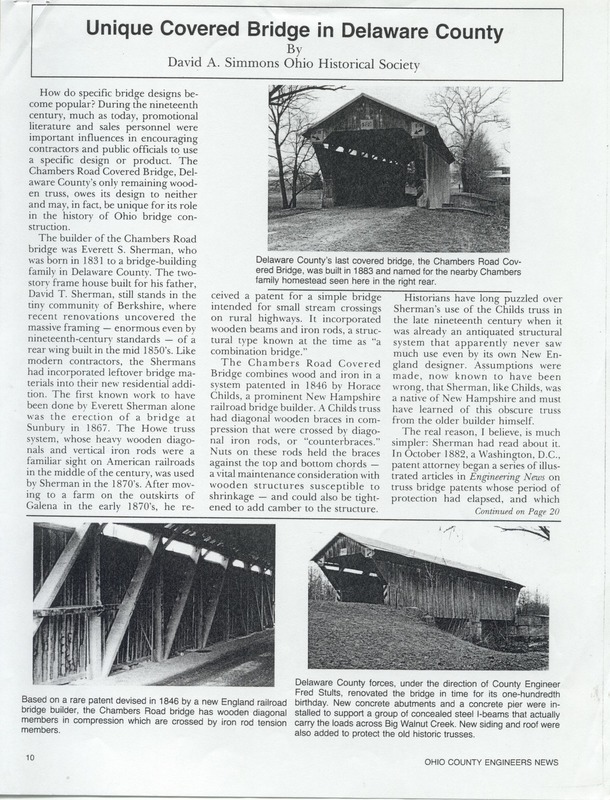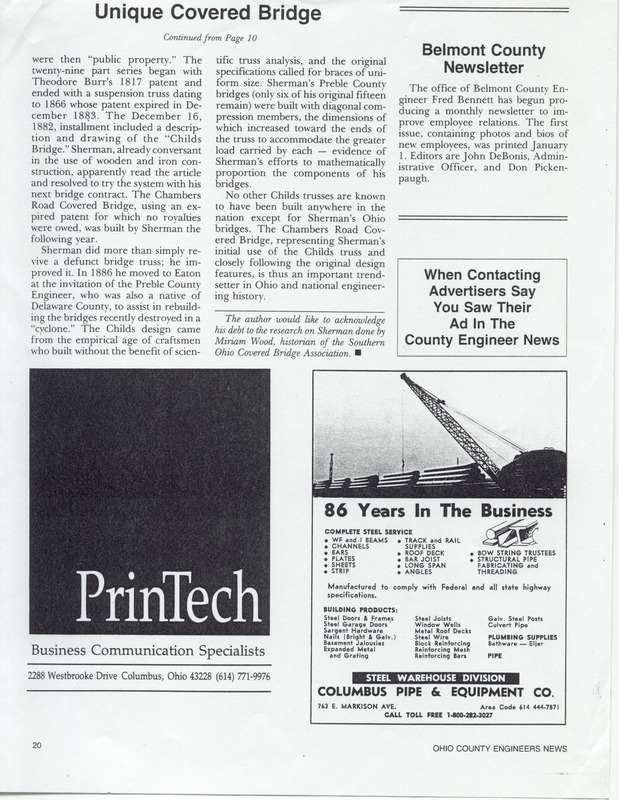Unique Covered Bridge in Delaware County
Title
Unique Covered Bridge in Delaware County (p. 1)
Description
Unique Covered Bridge in Delaware County
By
David A. Simmons Ohio Historical Society
How do specific bridge designs be-
come popular? During the nineteenth
century, much as today, promotional
literature and sales personnel were
important influences in encouraging
contractors and public officials to use
a specific design or product. The
Chambers Road Covered Bridge, Del-
aware County's only remaining wood-
en truss, owes its design to neither
and may, in fact, be unique for its role
in the history of Ohio bridge con-
struction.
The builder of the Chambers Road
bridge was Everett S. Sherman, who
was born in 1831 to a bridge-building
family in Delaware County. The two-
story frame house built for his father,
David T. Sherman, still stands in the
tiny community of Berkshire, where
recent renovations uncovered the
massive framing -enormous even by
nineteenth-century standards-of a
rear wing built in the mid 1850's. Like
modern contractors, the Shermans
had incorporated leftover bridge ma-
terials into their new residential addi-
tion. The first known work to have
been done by Everett Sherman alone
was the erection of a bridge at
Sunbury in 1867. The Howe truss
system, whose heavy wooden diago-
nals and vertical iron rods were a
familiar sight on American railroads
in the middle of the century, was used
by Sherman in the 1870's. After mov-
ing to a farm on the outskirts of
Galena in the early 1870's, he re-
ceived a patent for a simple bridge
intended for small stream crossings
on rural highways, It incorporated
wooden beams and iron rods, a struc-
tural type known at the time as "a
combination bridge."
[photo: Delaware County's last covered bridge, the Chambers Road Cov-
ered Bridge, was built in 1883 and named for the nearby Chambers
family homestead seen here in the right rear.]
The Chambers Road Covered
Bridge combines wood and iron in a
system patented in 1846 by Horace
Childs, a prominent New Hampshire
railroad bridge builder. A Childs truss
had diagonal wooden braces in com-
pression that were crossed by diago-
nal iron rods, or "counterbraces."
Nuts on these rods held the braces
against the top and bottom chords-
a vital maintenance consideration with
wooden structures susceptible to
shrinkage - and could also be tight-
ened to add camber to the structure.
[photo: Based on a rare patent devised in 1846 by a new England railroad
bridge builder, the Chambers Road bridge has wooden diagonal
members in compression which are crossed by iron rod tension
members.]
[photo: Delaware County forces, under the direction of County engineer
Fred Stults, renovated the bridge in time for its one-hundredth
birthday. New concrete abutments and a concrete pier were in-
stalled to support a group of concealed steel I-beams that actually
carry the loads across Big Walnut Creek. New siding and roof were
were also added to protect the old historic trusses.]
Historians have long puzzled over
Sherman's use of the Childs truss in
the late nineteenth century when it
was already an antiquated structural
system that apparently never saw
much use even by its own New En-
gland designer. Assumptions were
made, now known to have been
wrong, that Sherman,like Childs, was
a native of New Hampshire and must
have learned of this obscure truss
from the older builder himself.
The real reason, I believe, is much
simpler: Sherman had read about it.
In October 1882, a Washington, D.C.
patent attorney began a series of illus-
trated articles in Engineering News on
truss bridge patents whose period of
protection had elapsed, and which
By
David A. Simmons Ohio Historical Society
How do specific bridge designs be-
come popular? During the nineteenth
century, much as today, promotional
literature and sales personnel were
important influences in encouraging
contractors and public officials to use
a specific design or product. The
Chambers Road Covered Bridge, Del-
aware County's only remaining wood-
en truss, owes its design to neither
and may, in fact, be unique for its role
in the history of Ohio bridge con-
struction.
The builder of the Chambers Road
bridge was Everett S. Sherman, who
was born in 1831 to a bridge-building
family in Delaware County. The two-
story frame house built for his father,
David T. Sherman, still stands in the
tiny community of Berkshire, where
recent renovations uncovered the
massive framing -enormous even by
nineteenth-century standards-of a
rear wing built in the mid 1850's. Like
modern contractors, the Shermans
had incorporated leftover bridge ma-
terials into their new residential addi-
tion. The first known work to have
been done by Everett Sherman alone
was the erection of a bridge at
Sunbury in 1867. The Howe truss
system, whose heavy wooden diago-
nals and vertical iron rods were a
familiar sight on American railroads
in the middle of the century, was used
by Sherman in the 1870's. After mov-
ing to a farm on the outskirts of
Galena in the early 1870's, he re-
ceived a patent for a simple bridge
intended for small stream crossings
on rural highways, It incorporated
wooden beams and iron rods, a struc-
tural type known at the time as "a
combination bridge."
[photo: Delaware County's last covered bridge, the Chambers Road Cov-
ered Bridge, was built in 1883 and named for the nearby Chambers
family homestead seen here in the right rear.]
The Chambers Road Covered
Bridge combines wood and iron in a
system patented in 1846 by Horace
Childs, a prominent New Hampshire
railroad bridge builder. A Childs truss
had diagonal wooden braces in com-
pression that were crossed by diago-
nal iron rods, or "counterbraces."
Nuts on these rods held the braces
against the top and bottom chords-
a vital maintenance consideration with
wooden structures susceptible to
shrinkage - and could also be tight-
ened to add camber to the structure.
[photo: Based on a rare patent devised in 1846 by a new England railroad
bridge builder, the Chambers Road bridge has wooden diagonal
members in compression which are crossed by iron rod tension
members.]
[photo: Delaware County forces, under the direction of County engineer
Fred Stults, renovated the bridge in time for its one-hundredth
birthday. New concrete abutments and a concrete pier were in-
stalled to support a group of concealed steel I-beams that actually
carry the loads across Big Walnut Creek. New siding and roof were
were also added to protect the old historic trusses.]
Historians have long puzzled over
Sherman's use of the Childs truss in
the late nineteenth century when it
was already an antiquated structural
system that apparently never saw
much use even by its own New En-
gland designer. Assumptions were
made, now known to have been
wrong, that Sherman,like Childs, was
a native of New Hampshire and must
have learned of this obscure truss
from the older builder himself.
The real reason, I believe, is much
simpler: Sherman had read about it.
In October 1882, a Washington, D.C.
patent attorney began a series of illus-
trated articles in Engineering News on
truss bridge patents whose period of
protection had elapsed, and which
Publisher
Ohio County Engineers News
Title
Unique Covered Bridge in Delaware County (p. 2)
Description
Unique Covered Bridge
(Continued from Page 10)
were then "public property." The
twenty-nine part series began with
Theodore Burr's 1817 patent and
ended with a suspension truss dating
to 1866 whose patent expired in De-
cember 1883. The December 16,
1882, installment included a descrip-
tion and drawing of the "Childs
Bridge." Sherman, already conversant
in the use of wooden and iron con-
struction, apparently read the article
and resolved to try the system with his
next bridge contract. The Chambers
Road Covered Bridge, using an ex-
pired patent for which no royalties
were owed, was built by Sherman the
following year.
Sherman did more than simply re-
vive a defunct bridge truss; he im-
proved it. In 1886 he moved to Eaton
at the invitation of the Preble County
Engineer, who was also a native of
Delaware County, to assist in rebuild-
ing the bridges recently destroyed in a
"cyclone." The Childs design came
from the empirical age of craftsman
who built without the benefit of scien-
tific truss analysis, and the original
specifications called for braces of uni-
form size. Sherman's Preble County
bridges (only six of his original fifteen
remain) were built with diagonal com-
pression members, the dimensions of
which increased toward the ends of
the truss to accommodate the greater
load carried by each-evidence of
Sherman's efforts to mathematically
proportion the components of his
bridges.
No other Childs trusses are known
to have been built anywhere in the
nation except for Sherman's Ohio
bridges. The Chambers Road Cov-
ered Bridge, representing Sherman's
initial use of the Childs truss and
closely following the original design
features, is thus an important trend-
setter in Ohio and national engineer-
ing history.
The author would like to acknowledge
his debt to the research on Sherman done by
Miriam Wood, historian of the Southern
Ohio Covered Bridge Association.
(Continued from Page 10)
were then "public property." The
twenty-nine part series began with
Theodore Burr's 1817 patent and
ended with a suspension truss dating
to 1866 whose patent expired in De-
cember 1883. The December 16,
1882, installment included a descrip-
tion and drawing of the "Childs
Bridge." Sherman, already conversant
in the use of wooden and iron con-
struction, apparently read the article
and resolved to try the system with his
next bridge contract. The Chambers
Road Covered Bridge, using an ex-
pired patent for which no royalties
were owed, was built by Sherman the
following year.
Sherman did more than simply re-
vive a defunct bridge truss; he im-
proved it. In 1886 he moved to Eaton
at the invitation of the Preble County
Engineer, who was also a native of
Delaware County, to assist in rebuild-
ing the bridges recently destroyed in a
"cyclone." The Childs design came
from the empirical age of craftsman
who built without the benefit of scien-
tific truss analysis, and the original
specifications called for braces of uni-
form size. Sherman's Preble County
bridges (only six of his original fifteen
remain) were built with diagonal com-
pression members, the dimensions of
which increased toward the ends of
the truss to accommodate the greater
load carried by each-evidence of
Sherman's efforts to mathematically
proportion the components of his
bridges.
No other Childs trusses are known
to have been built anywhere in the
nation except for Sherman's Ohio
bridges. The Chambers Road Cov-
ered Bridge, representing Sherman's
initial use of the Childs truss and
closely following the original design
features, is thus an important trend-
setter in Ohio and national engineer-
ing history.
The author would like to acknowledge
his debt to the research on Sherman done by
Miriam Wood, historian of the Southern
Ohio Covered Bridge Association.
Dublin Core
Title
Unique Covered Bridge in Delaware County
Subject
Bridges--Construction--Delaware County--Ohio
History--Berkshire Township--Delaware County--Ohio
Porter Township--19th century--History
History--Berkshire Township--Delaware County--Ohio
Porter Township--19th century--History
Description
This article describes the construction method used by Berkshire resident Everett Sherman, builder of the Chambers Road bridge in Porter Township.
Creator
Author David A. Simmons; Ohio Historical Society
Publisher
Ohio County Engineer Number 1 Spring 1991
Date
1991
Contributor
Miriam Wood, historian of the Southern Ohio Covered Bridge Association.
Rights
http://rightsstatements.org/vocab/NoC-US/1.0/
Format
Magazine article
Language
English
Type
Still Image
Text
Text
Identifier
92961004
Collection
Citation
Author David A. Simmons; Ohio Historical Society, “Unique Covered Bridge in Delaware County,” Delaware County Memory, accessed November 28, 2024, https://955853.rosydayhk.tech/items/show/8.


